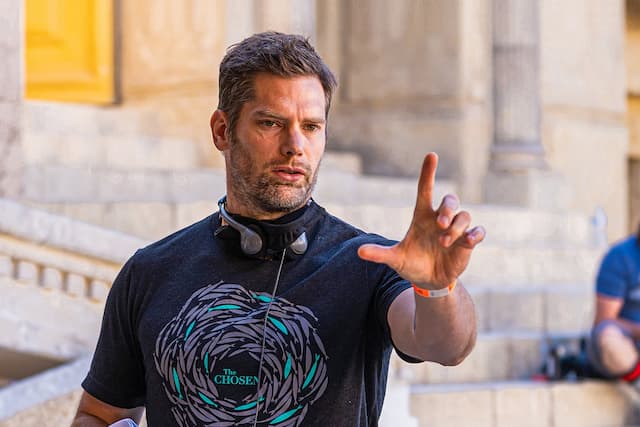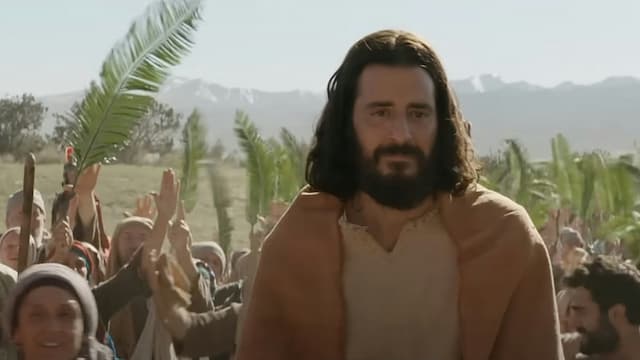The Need for Advanced Discipleship
Advanced discipleship training serves the most underserved people in the church: people who reach a midway point in their maturity but don’t get to “the other side.” This problem is predictable, because, by trying to communicate to a congregation with a wide range of spiritual growth, there is a tendency for leaders to aim for the middle. So that’s where their people end up!
Being in the middle, however, can be dangerous—whether it’s being in the middle of the road during the rush of oncoming traffic, or being in the middle of a lake when suddenly a rising and raging storm appears. Jesus didn’t want his disciples stuck in the middle. His command was for them to go to “the other side.”
Getting to the other side isn’t even a goal in most churches. When it comes to “perfecting the saints,” no serious effort is given to identify the characteristics and competencies of a “perfected saint,” or to formulate a scripturally-consistent strategy that will promote these qualities. Absent this goal, the believer makes significantly less progress than what could have been the case. The applicable rule of thumb being: We tend not to accomplish the goals we never set.
The Low-Goals Factor
Churches are clear about the beginning; they’re not as clear about the end. They focus on Alpha. They don’t focus on Omega. Churches can take believers to a midway point, perhaps, but they don’t take them to the other side. Instead, it is assumed, without examination, that if people hang around the church long enough, they’ll become perfected. The result of this approach is church members meandering in mediocrity, all because leaders didn’t recognize the need for advanced discipleship training.
In his work, The Complete Book of Discipleship, Bill Hull writes, “… it’s a huge mistake to think that we can simply learn the basics, flow into the general population and live off that.”1 Yet many churches have made this mistake. Commenting further, this discipleship leader declared, “The cause of Christ has paid a terrible price because of the mistaken concept that discipleship is only for beginners.” Too often, the care given to converts is soon withdrawn; and thereafter, they are on their own.
One hindering factor that keeps believers from “omega” truth is the quality of teaching the church offers. Churches do say something about selected pursuit-of-God dynamics—a blurb, a brief summary, a small nugget of truth—but omit way too much. There is more bud than bloom in these teachings, and therefore people receive only a pabulum portion of what was supposed to be meaty truth.
LCD (lowest common denominator) teaching may be popular, but it stunts people into carnality. What John MacArthur calls “birdbath preaching” can be so shallow it offers only a small puddle of truth—something stagnant, ever evaporating, and noticeably isolated from God’s rivers of living water! This preaching approach, ostensibly taken so no one is left out, remains the same year after year. The preacher goes no higher in year five than he did in year one. Even superb expositional preaching, however, has its limitations. Advanced discipleship has to be topical, and it has to be behavioral. Verse-by-verse, book-by-book preaching fails to draw together, with specificity and comprehension, what advanced discipleship training requires.
In order to set forth the holy habits of faith, the OMEGA Advanced Discipleship ministry is designed to compensate for these deficits by delving deeper. As Tozer put it, “You can live on froth and bubbles and little wisps of badly understood theology,”2 but there is a need for something more substantial. Instead of fill-in-the-blank discipleship, or a discipleship that does little more than identify major themes with bullet points and blurbs, a practical theology needs to be both thoroughly explained and profoundly experienced.
Second, the child of God has also been hindered by an LCD teaching that omits several pursuit-of-God dynamics entirely. The faithful become spiritually stuck, then, because of this one indefensible factor: LCD teaching presents only half a map! Taking to task this restricted itinerary, what may be called the longitude deficit in church teaching, A.W. Tozer wrote:
Something within the heart of normal man revolts against motion without progress. Yet this is precisely what we are offered in the vast majority of evangelical churches. Doctrinally these churches are moving around a tight and narrow circle. Their teachers tell them that this circle encompasses all the land of Beulah and warn them of the danger of looking for anything more.3
“It never seems to occur to anyone,” Tozer lamented, “that there is true joy farther on if they would only escape the circle and strike out for the hills of God.”4 Tozer likened the ordeal many people experience at church to being forced to remain in the third grade for five years even though the educational content of that grade was learned the first year. Why would any church do this? Mapping an itinerary that includes all those destinations worthy of God, and detours from all those dead-ends that strand the believer in defeat, makes obvious sense.
Advanced Discipleship Itinerary
It is from Scripture we learn that the journey from Egypt to Canaan delineates four distinct stages in the Christian life: stage 1) escaping Egypt, which represents securing our salvation; stage 2) dwelling in the wilderness, which represents learning the law and the failures of the flesh; stage 3) crossing the Jordan River, which represents holiness and the crucified life; and stage 4) entering the Promised Land, which represents the Spirit-filled life and the faith conquests that follow.
A major problem that discipleship must avoid is presenting only half a map. In order to increase awareness of this problem, ask yourself this question: How would you assess the leadership of Moses had he crossed the Red Sea but went no farther? Getting out of Egypt was a monumental blessing, to be sure; but was life on the other side of the Red Sea the best God had to offer? Surely you would agree that singing the song of Moses everyday while celebrating one’s salvation should never have been the end of this story. Yet, there are some churches today where this does seem to be the end of the story. Their one mission in life is to get people saved, and beyond that there isn’t much of a mission.
Consider a different scenario, one where Moses traveled farther and made his destination Sinai. Had this been the extent of his itinerary, Moses would have led his people to discover God’s laws, statutes, and precepts. And with these in hand, he could have camped out for a long time, just as many churches today have done by setting forth principles for daily life in sermon after sermon.
Yet God knew then what some leaders today seem not to know: This approach would have never gotten them out of the wilderness! The law, and all these statutes and principles, expose the flesh; they do not—and cannot—defeat it. Attempting to train the flesh with biblical principles only is utterly useless. God never wanted his people tramping around Sinai (Deuteronomy 1:6-8). The trajectory of their travel had a much better destination.
Kadesh, located on the boundary between the wilderness and the Promised Land, literally means “holiness.” This was supposed to be stage three in the journey. A.B. Simpson said that Kadesh “is a place where we either pass out of the wilderness … or where we pass on to the ceaseless round of failure and disappointment in which so many are living.”5 It’s one way or the other: Either the people of God accept the condition of holiness—the Jordan River, literally meaning death (the crucified life)—or they decide holiness isn’t for them and they move away from it.
It was at Kadesh where the vast majority of people decided not to listen to God, not listen to their leaders, but to return to the wilderness instead. Rejecting the holiness Kadesh promoted, the people of God made a fast U-turn and headed back to a way of life they really didn’t like.
Contemplate yet another alternative: What if Joshua led his people across the Jordan, but then, inexplicably, he and they decided to stay there? Had he and his people only gone that far, the Promised Land would have remained in the hands of those thirty-one kings, and the people of God would have missed out! Similarly, if we never proceed to stage four—experiencing the Spirit’s filling (called the promise in Luke 24:49) and implementing the faith that conquerors (I John 5:4)—we, too, will miss out on what the Promised Land represents.
Put in this way, are you now sensing the serious defects in itineraries with only half a map? To deliberately cut the journey short greatly deprives the people of God. The agenda for discipleship should include all the stages and strategies for experiencing Jesus from the moment of conversion to the most advanced stage of spiritual maturity. These four stages of Christian growth must factor into a well-conceived discipleship ministry, or the very real possibility exists that we’ll go no higher than promoting Sinai-like proficiency, turning out people who know precepts and principles but rarely experience the passion and progress that flows from consistently experiencing the presence of God.
Had we asked the people of God during Moses’ day if they had knowledge of Promised-Land living, they would have assured us they did, and could have offered up-close testimony to back that up. Yet, that kind of life was never their experience! They could talk about it, just as many Christians today can talk about it. But as Alexander Maclaren warned, it’s only talk. “The truth you do not live by becomes less and less real to you.”6 Maslow describes this sham as “non-peakers” talking to “non-peakers” about peak experience.
Clarifications About Omega
While OMEGA discipleship is well researched and doctrinally rich, its agenda isn’t one that tracks bible history or the full spectrum of theology. A more basic discipleship, prior to advanced discipleship, will teach doctrine (the authority of Scripture, the attributes of God, the doctrine of salvation, etc.) and the essentials of lordship (in marriage, parenting, finances, discovering and deploying spiritual gifts, etc.). OMEGA, however, focuses on the daily disciplines for a fully-functioning follower of Jesus.
In undertaking this agenda, OMEGA extends and expands some of the topics introduced in basic discipleship—prayer, for example, since prayer won’t derive its best understanding from those definitions set forth for the recently converted. Ditto faith, ditto Christian service, ditto processing God’s Word. None of the truths taught in OMEGA are academic or ancillary (meaning not really needed, just interesting).
OMEGA rivets its attention on providing instructions that intrigue, so seeking believers emerge from OMEGA with a godly grasp of the holy habits of faith.
The OMEGA Ministry involves:
1. Reading a chapter each week from OMEGA books (there are ten in this two-year program)
2. Sharing personal assessments and projecting scriptural solutions in their response to reflection questions at the end of each chapter
3. Meeting with a small group once a week (for an hour and a half) mentored by a leader, where participants take life-changing steps with the support of encouraging friends
4. Tracking the progress of new behaviors begun and old behaviors eliminated for a duration of time that better ensures needed changes are now locked in
OMEGA includes a group leader’s guide that provides training in effective group dynamics. Also, different scenarios with different contingencies are contemplated for every chapter of every book so the group leader can more effectively lead.
While everything in OMEGA is accessible (in terms of the language used) and practical (in terms of its applicability to daily life), OMEGA does have high standards. Oswald Chambers called this “My Utmost for His Highest”—and that is the course OMEGA follows! According to Jesus, it is the believer with “much fruit” who brings honor to the Father (John 15:8).
The church’s track record for bringing people to this level isn’t very impressive, and it also isn’t very surprising. Churches have been so afraid of presenting truth in a way that leaves people out, they have ended up doing this very thing. Only they’ve done it to the people who have been coming to church for a long while. They led them to the middle, and then left them there.
Some wonder if high goals discourage people from opting in. Actually, the reverse is more common. High goals motivate people by encouraging them to stop drifting and start purposing in a more serious, heart-felt, Spirit-energized way.
The best way to revive a church is to bring her more faithful members to a much higher level. Their freshly inspired zeal, increased knowledge, and ability to help others rise to a higher level of living (II Timothy 2:2) will bless the rest of the church.
OMEGA—a discipleship that delves deeper, a discipleship developing the holy habits of faith—is further explained on this website: www.omegaadvanceddiscipleship.com
Notes:
1. Bill Hull, “The Complete Book of Discipleship,” (NAVPress, Colorado Springs, CO., 2006), p.38.
2. A.W. Tozer, “Attributes of God,” volume 2, (Camp Hill, PA, Christian Publications, 2001), p.165.
3. A.W. Tozer, “The Warfare of the Spirit,” (Camp Hill, PA., Christian Publications, 1993), p.70.
4. Ibid., pp.70, 71.
5. A.B. Simpson, “The Holy Spirit,” Volume 1, (Telford, PA., Worthy Christian Library), online, chapter 5, paragraphs 6 and 7.
6. Leslie R. Keylock, “Alexander Maclaren,” (Fundamentalist Journal, January, 1989), p.58.











